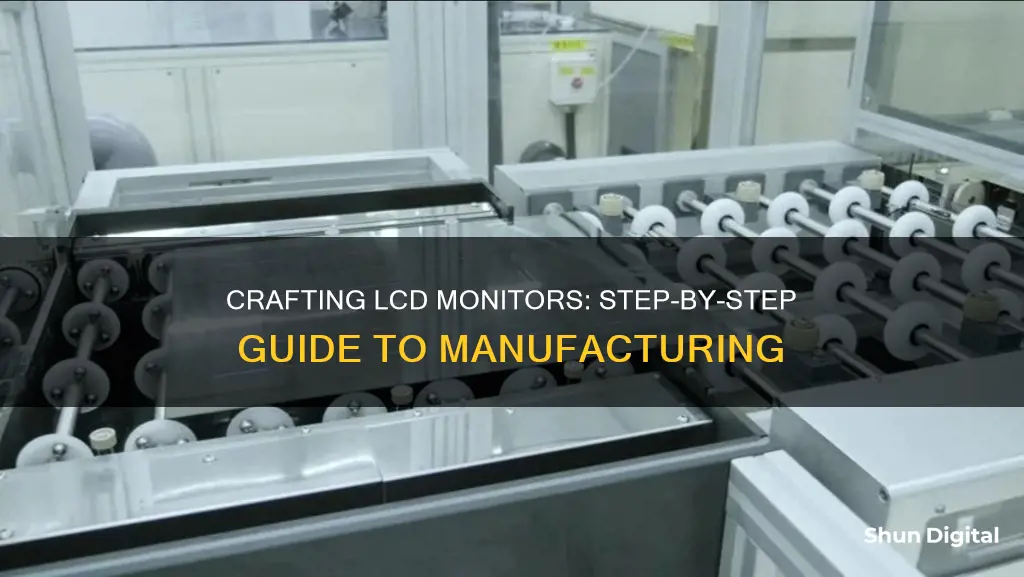
Liquid Crystal Displays (LCDs) are a type of flat-panel display that uses liquid crystals to display characters, images, and videos. They are commonly used in smartphones, televisions, computer monitors, and instrument panels. LCDs are made up of multiple layers, with two glass panels containing a thin layer of liquid crystals between them. The glass panels have grooves that direct the crystals, giving them a specific orientation. The liquid crystal panel is then illuminated by a light source, and the plane of polarization of the light beam is rotated. By controlling the voltage applied across the liquid crystal layer, light can be allowed to pass through in varying amounts, creating different levels of grey and forming an image.
What You'll Learn

Liquid crystals are neither solid nor liquid
The name "liquid crystal" may sound like a contradiction. We tend to think of a crystal as a solid material, like quartz, and a liquid as something completely different. However, there are some substances that can exist in a state that is partway between a liquid and a solid. This is where liquid crystals come in.
Liquid crystals are closer to a liquid state than a solid. It takes a fair amount of heat to change a substance from a solid into a liquid crystal, and only a little more heat to turn that liquid crystal into a liquid. This explains why liquid crystals are very sensitive to temperature and why they are used in thermometers and mood rings. It also explains why a laptop computer display may act up in cold weather or on a hot day.
Liquid crystals were first discovered in the 19th century by scientists who were trying to determine the molecular weight of cholesterol. They are now used in LCD screens because they have optic properties that can affect light when it passes through them.
Asus Monitor Power Cord Length Options Explored
You may want to see also

LCDs are made with a passive or active matrix display grid
Liquid-crystal displays (LCDs) are made with either a passive or active matrix display grid.
Passive-matrix LCDs use a grid of vertical and horizontal conductors made from Indium Tin Oxide (ITO) to create an image. Each pixel is controlled by the intersection of two conductors. A current is sent across two conductors on the grid to control the light for any pixel.
Passive-matrix LCDs are one of the oldest types of the technology, dating back to the early 1980s. They are also one of the simplest, but this simplicity comes with drawbacks. They have a slow response time and imprecise voltage control. This means that passive-matrix LCDs struggle with refreshing displayed images and influencing only one pixel at a time.
Active-matrix LCDs, on the other hand, use thin-film transistors (TFT) that are arranged in a matrix on a glass surface. They also feature a back panel made of silicon, which allows for the creation of a transistor for every pixel. As a result, active-matrix LCDs can produce better images with higher contrast, lower response time and improved viewing angles. They are also able to switch pixels on and off more frequently, improving the screen refresh time.
Active-matrix LCDs are typically more expensive than passive-matrix LCDs, but many consumers and business owners believe the improved performance makes them a worthwhile investment.
Inns and Internet Privacy: What You Need to Know
You may want to see also

LCDs are flat-panel displays
LCDs are made up of two pieces of polarised glass with a thin layer of liquid crystals between them. The glass has grooves that direct the crystals, giving them a distinctive orientation. The grooves are parallel on each panel but perpendicular between the two. The liquid crystal panel is illuminated by a light source, and the plane of polarisation of the light beam is rotated by 90 degrees as it passes through. When an electric field is applied, the molecules partially align with it, and the angle of the polarisation plane changes.
LCDs are made with either a passive matrix or an active matrix display grid. The passive matrix LCD has a grid of conductors with pixels located at each intersection in the grid. A current is sent across two conductors to control the light for any pixel. An active matrix has a transistor located at each pixel intersection, requiring less current to control the luminance of a pixel.
LCDs are available to display arbitrary images or fixed images with low information content. They use the same basic technology, except that arbitrary images are made from a matrix of small pixels, while other displays have larger elements. Each pixel of an LCD typically consists of a layer of molecules aligned between two transparent electrodes and two polarising filters. Without the liquid crystal between the polarising filters, light passing through the first filter would be blocked by the second.
LCDs are now being replaced by new display technologies such as OLEDs, which use a single glass or plastic panel.
Finding the Right Monitor Size for You
You may want to see also

LCDs are made of two pieces of polarised glass
One of the glass pieces is then coated with a layer of nematic liquid crystals. The grooves cause the first layer of molecules to align with the orientation of the polarising film. The second piece of glass is then added, with its polarising film at a right angle to the first piece. Each successive layer of TN molecules will gradually twist until the uppermost layer is at a 90-degree angle to the bottom, matching the polarised glass filters.
As light strikes the first filter, it is polarised. The molecules in each layer then guide the light to the next layer. As the light passes through the liquid crystal layers, the molecules also change the light's plane of vibration to match their own angle. When the light reaches the far side of the liquid crystal substance, it vibrates at the same angle as the final layer of molecules. If the final layer is matched with the second polarised glass filter, then the light will pass through.
LCD Monitors: China Tariff List Concerns for Buyers
You may want to see also

LCDs are made of liquid crystals that can be electronically switched on and off
Liquid crystals are substances that are in a permanent liquid state but have some properties inherent in crystal bodies. They are made up of rod-shaped molecules that can be categorized as either thermotropic or lyotropic. Thermotropic liquid crystals react to changes in temperature or pressure, while lyotropic liquid crystals are used in the manufacture of soaps and detergents.
The liquid crystals in LCDs are sandwiched between two pieces of polarized glass, with a layer of liquid crystals between them. This creates a distinctive orientation for the crystals, as the panels have flutes that direct them. The liquid crystal panel is then illuminated by a light source, and the plane of polarization of the light beam is rotated by 90 degrees as it passes through.
When an electric field is applied, the molecules of the liquid crystals change their orientation and partially align with the electric field, altering the angle of the light passing through them. This allows the liquid crystals to be electronically switched on and off, as they can be controlled to either transmit or block light.
The liquid crystals in LCDs are arranged in a matrix of small segments called pixels, which can be manipulated to display information. Each pixel consists of a layer of molecules aligned between two transparent electrodes and two polarizing filters. By controlling the voltage applied across the liquid crystal layer in each pixel, the amount of light passing through can be adjusted, creating different levels of grey.
LCDs are commonly used in televisions, computer monitors, smartphones, digital cameras, watches, calculators, and other electronic devices. They offer several advantages over older display technologies, such as cathode ray tubes (CRTs), including thinner form factors, lower power consumption, and higher image quality.
Understanding Monitor Types: LED vs LCD Displays
You may want to see also
Frequently asked questions
LCD stands for Liquid Crystal Display. It is a type of flat panel display that uses liquid crystals to display information.
LCD monitors use the light-modulating properties of liquid crystals combined with polarizers to display information. They do not emit light directly but instead use a backlight or reflector to produce images in color or monochrome.
Liquid crystals are substances that can exist in a state that is somewhere between a liquid and a solid. They have the molecules of a liquid, which can change their orientation and move around, but they also maintain the orientation of a solid.
LCD monitors are made with either a passive matrix or an active matrix display grid. The passive matrix LCD has a grid of conductors with pixels located at each intersection in the grid. The active matrix LCD, also known as a thin film transistor (TFT) display, has a transistor located at each pixel intersection.







